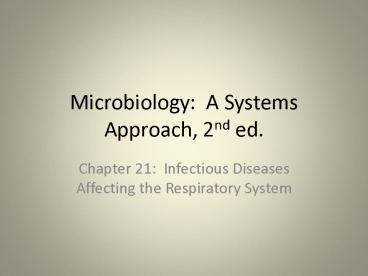Microbiology: A Systems Approach, 2nd ed' - PowerPoint PPT Presentation
1 / 24
Title:
Microbiology: A Systems Approach, 2nd ed'
Description:
A number of infectious agents affect both the upper and lower ... tubercles break down into necrotic caseous lesions that gradually heal by calcification ... – PowerPoint PPT presentation
Number of Views:144
Avg rating:3.0/5.0
Title: Microbiology: A Systems Approach, 2nd ed'
1
Microbiology A Systems Approach, 2nd ed.
- Chapter 21 Infectious Diseases Affecting the
Respiratory System
2
21.4 Diseases Caused by Microorganisms Affecting
the Upper and Lower Respiratory Tract
- A number of infectious agents affect both the
upper and lower respiratory tract regions - Most well-known whopping cough, respiratory
syncytial virus (RSV), and influenza
3
Whooping Cough
- Also known as pertussis
- Two distinct symptom phases
- Catarrhal stage
- After incubation from 3 to 21 days
- Bacteria in the respiratory tract cause what
appear to be cold symptoms (runny nose) - Lasts 1 to 2 weeks
- Paroxysmal stage
- Severe and uncontrollable coughing
- Violent coughing spasms can result in burst blood
vessels in the eyes or even vomiting - Followed by a long recovery (convalescent) phase
- Complete recovery requires weeks or even months
- Other microorganisms can more easily cause
secondary infection
4
(No Transcript)
5
Respiratory Syncytial Virus Infection
- Produces giant multinucleated cells (syncytia) in
the respiratory tract - Most prevalent cause of respiratory infection in
the newborn age group - First symptoms fever that lasts approximately 3
days, rhinitis, pharyngitis, and otitis - More serious infections give rise to symptoms of
croup coughing, wheezing, dyspnea, rales
6
(No Transcript)
7
Influenza
- Begins in the upper respiratory tract serious
cases may also affect the lower respiratory tract - 1- to 4-day incubation period
- Symptoms begin very quickly headache, chills,
dry cough, body aches, fever, stuffy nose, and
sore throat - Extreme fatigue can last a few days or a few weeks
8
Figure 21.12
9
Figure 21.13
10
(No Transcript)
11
21.5 Lower Respiratory Tract Diseases Caused by
Microorganisms
- Diseases that affect the bronchi, bronchioles,
and lungs - Tuberculosis and pneumonia
12
Tuberculosis
- Humans are easily infected with Mycobacterium
tuberculosis but are resistant to the disease - Only about 5 of infected people actually develop
a clinical case of TB - Untreated TB progresses slowly
- Clinical TB is divided into primary tuberculosis,
secondary tuberculosis, and disseminated
tuberculosis
13
Primary Tuberculosis
- Period of hidden infection- asymptomatic or
accompanied by mild fever - After 3 to 4 weeks, immune system mounts a
cell-mediated assault- large influx of
mononuclear cells into lungs - Tubercles form
- Frequently the centers of tubercles break down
into necrotic caseous lesions that gradually heal
by calcification - Tuberculin reaction
14
Secondary (Reactivation) Tuberculosis
- Live bacteria can remain dormant and become
reactivated weeks, months, or years later - Chronic tuberculosis tubercles filled with
bacteria expand and drain into bronchial tubes
and upper respiratory tract severe symptoms such
as violent coughing, greenish or bloody sputum,
low-grade fever, anorexia, weight loss, extreme
fatigue, night sweats, chest pain
15
Extrapulmonary Tuberculosis
- Outside of the lungs
- More common in immunosuppressed patients and
young children - Regional lymph nodes, kidneys, long bones,
genital tract, brain, and meninges - Complications are usually grave
16
Figure 21.19
17
(No Transcript)
18
Pneumonia
- Anatomical diagnosis
- Inflammatory condition of the lung in which fluid
fills the alveoli - Can be caused by a wide variety of different
microorganisms - Viral pneumonias are usually milder than
bacterial - Community-acquired vs. nosocomial pneumonias
- Begin with upper respiratory tract symptoms,
including runny nose and congestion - Headache common
- Fever is often present
- Onset of lung symptoms follows chest pain,
fever, cough, discolored sputum
19
Figure 21.20
20
Figure 21.21
21
Figure 21.22
22
(No Transcript)
23
(No Transcript)
24
Figure 21.26































